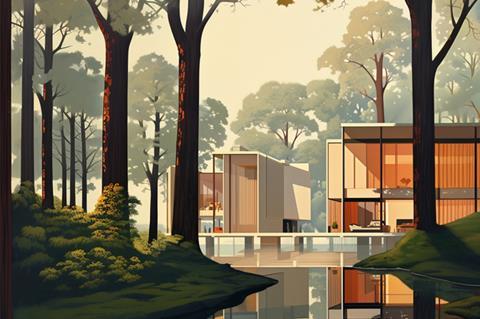In the final article of this series, Keir Regan-Alexander looks at how new technology could revolutionise approaches to technical design and procurement

In the fifth and final post of this series we are pondering the idea that we may be about to usher in an age where we shift from “procurement” to “Pre-procurement”. Yes this is a cringe play on words, but hopefully it firmly lodges the idea of bringing the specification, pricing and procurement of whole buildings systems much further forward in the design process. It’s perhaps most directly applicable to RIBA 4 / AIA CD.
Anyone who is familiar with working on larger scale projects with established main contractors will know that often the margin that the contractor can achieve is dependent on their particular supply chain and how well suited it is to a given project, brief and site constraints. One contractor may have an edge over another on their ability and domain specific knowledge around a pivotal aspect of the project, allowing them to offer greater certainty on, for example, timely delivery on sites that cannot permit extended downtime or delay.
There is now an emergent potential for design work to be market tested for system prefabrication and even “value engineered” way ahead of time. More and more, design teams are being tasked with preparing critical aspects of a project for market testing early. This requires detail that would otherwise be prepared later, to instead be compiled ahead of time and out of sequence.
Project Managers and clients like to do this because it can validate a design strategy that might be making them nervous. The more we know about the readiness of the supply chain to deliver a design, the more confidence the client can feel about pricing and programme (and when it comes to prefabrication, some would say quality). This idea is being realised now using Generative Design in a number of ways:
Kope are creating a platform that links the supply chain directly to the project modelling environment, allowing for a design of, say, a proprietary wall system to be tested for suitability very early and the design adjusted upstream accordingly. This idea opens the door to “live pricing” of projects and far greater certainty about how a building could be prefabricated in advance of having a main contractor on board.
Swapp are looking to automate project documentation, by going from auto-generated 3D forms to detailed documentation in hours. Their approach involves the novel configuration of a pre-determined library of components, assemblies and products; and this allows a more catalogue approach to procurement: “I’ll have one of those, but with different coloured cladding and a basement car park please”.
I can feel architects shudder as they read this, but we have to think about it from a client’s perspective - it’s possible this is indeed what a large section of the client market actually wants. I don’t much like the idea, but the proof will be in the success or failure of such projects to achieve adoption.
Modulous are combining generative design planning, automated documentation and direct links to supply chain in an end-to-end development model that could see them partner with a developer, generate a concept, generate project documents and connect directly to constructors who’s preferences are already baked into the component libraries and prototypes - thus reducing waste, building with greater speed and enabling wider adoption of offsite manufacture.
Be Careful of:
A. Autoplay. This kind of approach is likely to appeal to the most commercially minded clients because it offers standardisation and speed. But by short circuiting the usual dialogue and deeper level of engagement that is typical for a full design process we risk deploying a “design by rote” approach that is only optimised for utility and efficiency.
Where is the right balance point between the reusing of norms that “work” for greater efficiency and making everything the same way? Taking this idea to its extreme; our cities could become an endless Truman Show set, uncannily familiar but ultimately nowhere in particular.
Geography also feels particularly important to this trend; these fledgling start ups are chasing the start-up holy grail of worldwide adoption, but so much of the doing of architecture is heavily contingent on predominantly localised construction detailing, local skills and local supply chains. This difficulty is compounded by regulation and conventions that vary strongly based on location.
Can these catalogue based solutions work beyond the bounds of individual countries, or local regional controls? Maybe they are thinking this is where the architect comes in.
B. Tail Wagging Dog. There could come a time that we are pricing and de-risking ideas before they have been allowed to truly get off the ground. Such a change, while providing greater certainty on cost and manufacturing, would lead to a very constraining and fraught design environment that is hostile to new ideas, maybe even hostile to the very idea of design.
Sometimes the best ideas on projects (that generate the greatest value for clients), arise from “first principles” thinking, which means taking fundamental knowledge from disparate fields and combining it in new ways. In a world where we invite the supply chain into the design process very early, we risk never questioning such assumptions.
C. Stifling Innovation. By preparing a design for a narrow supply chain and re-using systems endlessly we could unwittingly create narrow monopolies where a system is sold early and upstream of the building process. This would be good for suppliers but would it be good for pricing or environmental performance long term?
Monopolistic behaviours ultimately lead to a net loss of innovation (it goes against incumbent incentive structures). As an example of this - look at mass house building in the UK. An ideal approach would be to prepare designs for a wide range of suppliers in a given area with a loose fit approach, thus enabling real competition and innovation to happen.
On the horizon…

My focus for this initial series has been on work stages up to Technical Design, where we are most likely to see changes to the professional role of architects. However the concept of using a Machine Learning approach to run predictions has wide ranging benefits for construction beyond generative design and drafting tools in the pre construction stages.
Here are three such applications of prediction modelling that are already tackling impactful problem areas:
- Live prediction of a construction project “completeness” and detection of coordination errors on site using simple one-person hardhat mounted video cameras, as Doxel are doing.
- Preoptima are working on rapid carbon CLA prediction direct from initial 3D model geometry with a goal to push low carbon decision making much earlier in the design process.
- Use of prediction modelling for environmental performance analysis in leiu of compute-heavy CFD analysis. This allows near instant A/B testing of wind, daylight and sunlight within an acceptable margin of error before full assessment - as Forma are doing.
Final note, I am grouping products that are using parametric “Generative Design” and/or “Generative AI” together, because from a user and product perspective they offer much of the same benefits. While the differences in how these technologies achieve their outcome is incredibly interesting, most architects have a greater interest in what a tool can do for them, rather than how it does it.
>> Also read: The first movers creating Generative Design & AI tools for architecture
>> Also read: Generative Design & AI Trends: ‘Auto Optioneering’
>> Also read: Generative Design & AI Trends: ‘Hybrid Collage’
>> Also read: Generative Design & AI Trends: ‘Leveraged Drafting’
Postscript
Keir Regan-Alexander is an AEC Domain Expert and Consulting Director operating at the intersection of architecture practice, sustainable development and software design. Connect on LinkedIn
















No comments yet